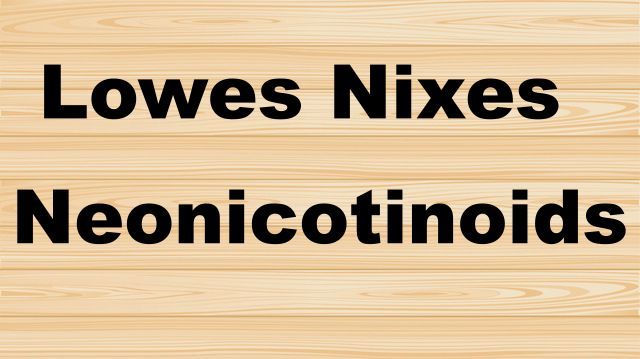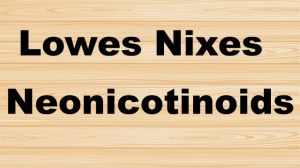
There has recently been an announcement of good news for our environment, which may end up being quite far-reaching: The large home improvement chain, Lowe’s, has announced it will phase out the sale of neonicotinoid pesticides, including those plants and products treated with them, by 2019.
Lowe’s decision to put an end to its sale of these products follows Home Depot’s requirement of neonicotinoid labeling in 2014, as well as the request by BJ’s Wholesale Club to have vendors exclusively provide neonicotinoid-free products—or at least to label them—by the close of 2014.
So what’s the big deal about neonicotinoids? The link between this class of pesticide and the mass deaths of bees across the planet, known as Colony Collapse Disorder (CCD), is becoming more apparent. The steps taken by Lowe’s and other retailers signify that attention is finally being paid to the grave potential consequences of using neonicotinoids.
Links to Colony Collapse Disorder (CCD)
The sad fact is, our Earth’s bees are dying—and in large numbers. In the time period between the 1940s and today, the bee population in America has been cut approximately in half. On top of that, in the winter of 2012–2013, about 30 percent of our nation’s honeybees were lost—and this has experts extremely worried.
While there are many suspected factors that may be contributing to CCD—and the cause is not yet known with certainty—mounting evidence suggests that neonicotinoids may have a notable role in this phenomenon.
In fact, the links are so strong that the European Union (EU) decided to ban three types of neonicotinoids back in 2013. As to the reasons, the Pesticide Action Network (PAN) explains:
“The EU vote comes after significant findings by the European Food Safety Agency that these pesticides pose an unacceptable risk to bees and their use should be restricted. Along with habitat loss and pathogens, a growing body of science points to neonicotinoid pesticides as a key factor in dramatically declining bee populations.”
The 2014 Gardeners Beware Report
In 2014, the Gardeners Beware Report, compiled by the environmental collective, Friends of the Earth US, uncovered some troubling research on neonicotinoids. As the authors of the report explain:
“Neonicotinoids are systemic pesticides that are taken up through roots and leaves and distributed throughout the entire plant, including pollen and nectar. These pesticides can poison bees directly, but even low-level exposure can lead to sublethal effects such as altered learning, impaired foraging and immune suppression, which exacerbates the lethality of pathogen infections and mite infestations.”
For their report, the researchers who contributed to the report studied 18 cities across the United States and Canada, and analyzed the levels of neonicotinoids found in greenhouse flowers. Both the stems and the leaves of the plants were tested. Some of the plants tested are commonly thought by many to be “bee friendly” plants.
Frighteningly, results of the analysis showed that 51 percent of the plants bought at Home Depot, Walmart, and Lowes contained neonicotinoids—in concentrations that were deemed to have the potential to cause adverse effects, including death, to bees. Also, 40 percent of the samples tested positive for two or more types of neonicotinoids.
The report authors write, “For the samples with positive detections, adverse effects on bees and other pollinators consuming nectar and pollen from these plants are possible, ranging from sublethal effects on navigation, fertility, and immune function to pollinator death.”
Timothy Brown of the Pesticide Research Institute adds, “Unfortunately, these pesticides don’t break down quickly so these plants could be toxic to bees for years to come.”
What about wild bees? The Lund University field study
While much of the research surrounding neonicotinoids and bee populations has focused on honeybees, a new study, performed by researchers at Lund University in Sweden and published in the journal Nature, included wild bees in the analysis. Wild bees analyzed consisted of bumblebees, as well as solitary bees.
Specifically, the study analyzed the effects of the neonicotinoid, clothianidin, on the bees around rapeseed fields.
According to Maj Rundlof, the principal investigator and coordinator of the Lund University study, “We saw a clear negative impact on growth and ability to reproduce in bumblebee colonies near treated rapeseed fields.”
On their results, the study authors wrote the following:
“In a study with replicated and matched landscapes, we found that seed coating with Elado, an insecticide containing a combination of the neonicotinoid clothianidin and the non-systemic pyrethroid β-cyfluthrin, applied to oilseed rape seeds, reduced wild bee density, solitary bee nesting, and bumblebee colony growth and reproduction under field conditions. Hence, such insecticidal use can pose a substantial risk to wild bees in agricultural landscapes, and the contribution of pesticides to the global decline of wild bees may have been underestimated.”
The effect of the neonicotinoid-coated rapeseed on the honeybees was not found to be statistically significant in this study, and it is unclear as to why. However, as Rundlof observes, “If we only investigate how a new pesticide affects honeybees, that is not sufficient to predict the consequences for wild bees in a real landscape.”
So, how important are bees, really?
Short answer: very important. Bees alone are responsible for pollinating about a quarter of the foods commonly eaten in the United States. Worldwide, about two thirds of the crops eaten by humans daily rely on bees and other pollinating insects for their survival. If you like to have a wide selection of fruits and veggies on hand, you may wish to consider the vital role of the bees in our food chain.
To bring this point home, in 2013, Whole Foods Market and the Xerces Society launched a campaign entitled “Share the Buzz.” As part of this campaign, one Whole Foods location physically removed all of the produce from the store that would have ceased to be there should the bee population die away. Of the 453 types of produce, about 237 were taken off the shelves.
The foods removed included common superfoods such as broccoli, cucumbers, kale, apples, lemons, limes, carrots, mangoes, celery and summer squash. These foods are not only delicious, they are important sources of necessary nutrients.
Another potential ill effect of the disappearance of bees would be malnutrition– sometimes severe – in many parts of the world. Researchers point to folate deficiency and vitamin A deficiency as potential consequences—both of which can lead to serious developmental and pathogenic illnesses.
Impacts on other species
 It’s not just bees that neonicotinoids hurt, either. A recent study performed at Radboud University in the Netherlands found that exposure to neonicotinoids could negatively affect bird populations, as well.
It’s not just bees that neonicotinoids hurt, either. A recent study performed at Radboud University in the Netherlands found that exposure to neonicotinoids could negatively affect bird populations, as well.
This study specifically focused on 15 species of birds. The populations of these 15 species was recorded between 2003 and 2007, and analyzed against the levels of neonicotinoids found in waters around their habitats. Results showed that in areas in which the neonicotinoid levels were the highest, the populations of farmland foul exhibited declines.
In areas where the neonicotinoid levels were sampled as over 20 nanograms per liter, the populations of such birds as starlings, barn swallows, and tree sparrows fell by about 3.5 percent per year, compared to average population trends for each species.
According to Radboud researchers, these effects may be happening for several reasons. The researchers hypothesize that the neonicotinoid levels in the water may be directly harming smaller birds. On top of that, the insects—including pollinators—that these pesticides destroy serve as a food source for many of these birds.
Furthermore, since neonicotinoid pesticide use is so widespread, many of the foods we humans directly ingest may contain traces of these chemicals. It seems clear that these chemicals do not belong anywhere near our bodies—or anywhere in our food supply.
We hope that more and more corporations follow Lowe’s example and discontinue their sale of neonicotinoids. Our world’s pesticide use—of this class and other dangerous pesticide types—is out of control, and we need to work towards finding agricultural solutions that work with Mother Nature, rather than against her.
-The Alternative Daily
Sources:
http://newsdaily.com/2015/04/lowes-to-eliminate-pesticides-that-hurt-crop-pollinating-honeybees
http://www.foe.org/news/news-releases/2015-04-lowes-commits-to-protect-bees-and-pollinators
http://libcloud.s3.amazonaws.com/93/3a/3/4738/GardenersBewareReport_2014.pdf
http://www.sciencedaily.com/releases/2015/04/150422135754.htm
http://www.nature.com/nature/journal/vaop/ncurrent/full/nature14420.html
http://www.wholefoodsmarket.com/pollinators
https://www.thealternativedaily.com/bees-die-malnutrition-concerns-rise
https://www.thealternativedaily.com/pesticides-banned-by-european-union-approved-by-epa
https://www.thealternativedaily.com/85-of-earths-food-relies-on-bees-and-its-in-danger
http://www.ru.nl/science/@944790/pagina

